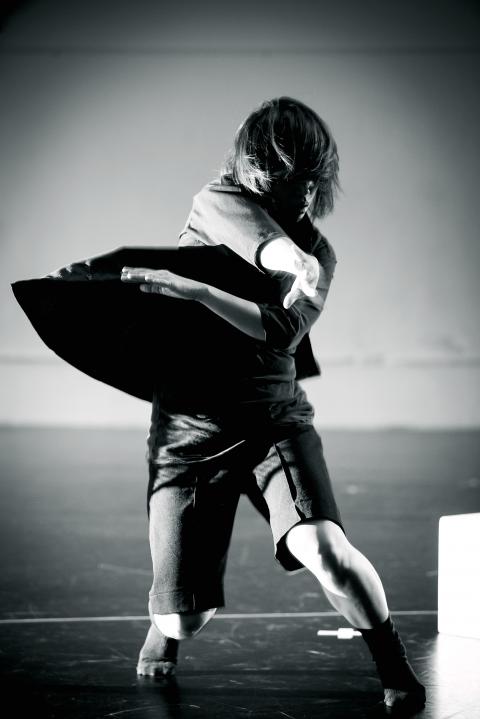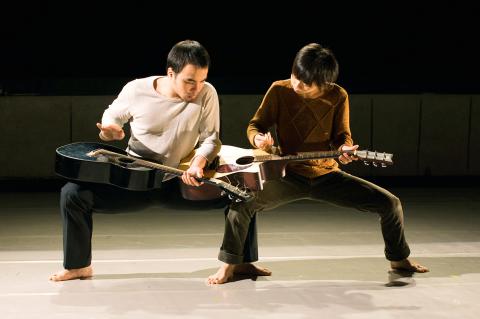Dancer/choreographer Chou Shu-yi’s (周書毅) Next Choreography Project (下一個編舞計畫) has returned for its second year at the Huashan 1914 Creative Park to introduce Taipei audiences to six up-and-coming young choreographers.
The program is entitled Discovery — Fresh Creative People (發現-創作新鮮人), and it is exactly that lure of discovering unknown fledgling artists — perhaps the “next big one” — that fuels the Next project.
Having established a name for himself, Chou last year decided to try and help others forge their own success by establishing a dance laboratory of sorts, one that would provide a forum for new choreographers and students.

Photo: Courtesy of Chen Chang-chih
Chou has said the origins of the Next Choreography Project were questions that have been central to his own creative development, ones that he feels are not thoroughly addressed when learning to dance or to choreograph in Taiwan — what exactly is choreography and why do we choreograph?
Six young choreographers will attempt to answer those questions this weekend at Huashan.
Unlike last year’s show, when the eight choreographers were selected from basically unknown dance students or graduates nationwide, two of this year’s crop have already begun to develop a name for themselves — Hsu Cheng-wei (許程崴) and Liu Kuan-hsiang (劉冠詳).

Photo: Courtesy of Chen Chang-chih
Hsu has had works performed by the Kaohsiung City Ballet (高雄城市芭蕾舞團) as part of its Dance Shoe 2010 and 2011 programs, among others. Liu worked with dance collective Horse (驫舞劇場) in their monumental Successor (繼承者) show last year at Huashan.
The five works in the show are a mix of solos and duets and all six choreographers also do double duty as dancers.
Hsu’s solo is called No Lines (沒有線條), while Liu has created a duet entitled Fog (霧) that he will dance with Chien Ching-ying (簡晶瀅).
Lin Su-lian’s (林素蓮) solo is entitled Inward (裡面), Chang Jing-ju (張靜如) and Wu Yi-juan (吳宜娟) created a duet entitled Elur (見夫) and Tsai Yi-jie’s (蔡依潔) solo is called If you still remember (如果你也還記得), inspired by Lo Chiao-ling’s (羅喬綾) work by the same name.
Each choreographer was free to select his/her/their own collaborators for sound, costumes and visual media, aided by a line-up of experienced production consultants who included fashion designer Lin Ching-ju (林璟如) and sound artist Hsu Yen-ting (許雁婷).
“Discovery — Fresh Creative People” is truly a voyage of discovery for both the creators and audiences alike.

Nov. 11 to Nov. 17 People may call Taipei a “living hell for pedestrians,” but back in the 1960s and 1970s, citizens were even discouraged from crossing major roads on foot. And there weren’t crosswalks or pedestrian signals at busy intersections. A 1978 editorial in the China Times (中國時報) reflected the government’s car-centric attitude: “Pedestrians too often risk their lives to compete with vehicles over road use instead of using an overpass. If they get hit by a car, who can they blame?” Taipei’s car traffic was growing exponentially during the 1960s, and along with it the frequency of accidents. The policy

Hourglass-shaped sex toys casually glide along a conveyor belt through an airy new store in Tokyo, the latest attempt by Japanese manufacturer Tenga to sell adult products without the shame that is often attached. At first glance it’s not even obvious that the sleek, colorful products on display are Japan’s favorite sex toys for men, but the store has drawn a stream of couples and tourists since opening this year. “Its openness surprised me,” said customer Masafumi Kawasaki, 45, “and made me a bit embarrassed that I’d had a ‘naughty’ image” of the company. I might have thought this was some kind

What first caught my eye when I entered the 921 Earthquake Museum was a yellow band running at an angle across the floor toward a pile of exposed soil. This marks the line where, in the early morning hours of Sept. 21, 1999, a massive magnitude 7.3 earthquake raised the earth over two meters along one side of the Chelungpu Fault (車籠埔斷層). The museum’s first gallery, named after this fault, takes visitors on a journey along its length, from the spot right in front of them, where the uplift is visible in the exposed soil, all the way to the farthest

The room glows vibrant pink, the floor flooded with hundreds of tiny pink marbles. As I approach the two chairs and a plush baroque sofa of matching fuchsia, what at first appears to be a scene of domestic bliss reveals itself to be anything but as gnarled metal nails and sharp spikes protrude from the cushions. An eerie cutout of a woman recoils into the armrest. This mixed-media installation captures generations of female anguish in Yun Suknam’s native South Korea, reflecting her observations and lived experience of the subjugated and serviceable housewife. The marbles are the mother’s sweat and tears,